Sarah Sundin's Blog, page 470
July 13, 2012
Today in World War II History
70 Years Ago—July 13, 1942: Nazis massacre 5000 Jews in Rovno, Ukraine and 1500 in Josefov, Poland.
Published on July 13, 2012 03:00
July 12, 2012
Book Beat - Wedded to War by Jocelyn Green
 While researching the history of nursing for my own novels, I was stunned by what I read about nursing in the Civil War. Rather than the romanticized view prevalent in modern movies and novels about the era, nursing was considered a scandalous choice for a woman, and female nurses had to fight for the ability to care for the sick and wounded.
While researching the history of nursing for my own novels, I was stunned by what I read about nursing in the Civil War. Rather than the romanticized view prevalent in modern movies and novels about the era, nursing was considered a scandalous choice for a woman, and female nurses had to fight for the ability to care for the sick and wounded.In Wedded to War , Jocelyn Green takes a well-researched look at Civil War nurses, a view that's even more fascinating with the romanticized notions stripped away. Charlotte Waverly is a proper young society lady, teetering dangerously on the brink of spinsterhood. Handsome Phineas Hastings promises to rescue her from that fate, but the start of war ignites a passion inside Charlotte to do something for the war effort. However, her choice to become a nurse - quite shocking at the time - earns her mother's disapproval, Phineas's wrath, and a life dramatically different from what she knows.
Fascinating, dramatic, and romantic, Wedded to Warby Jocelyn Green sheds light on the harrowing world of Civil War nursing through the eyes of a delightful heroine. Detailed research and a powerful message about mercy make this story a keeper. This is the first in the Heroines Behind the Lines Civil War series, and I'm much anticipating the second book!
Visit the amazing Heroines Behind the Lines website to see maps, historical photographs, character sketches, and a historical/story timeline. It is gorgeous!
**LATE ADDITION** Jocelyn has graciously offered to send out one autographed copy to a commenter! Leave a comment below and I'll enter you in a drawing and announce the winner next Tuesday 7/17.
Published on July 12, 2012 05:00
Today in World War II History
70 Years Ago—July 12, 1942: Australians reach Kokoda, New Guinea, having marched from Port Moresby over Owen Stanley Mountains.
Published on July 12, 2012 03:00
July 11, 2012
Today in World War II History
70 Years Ago—July 11, 1942: FBI arrests 158 German citizens in New York in spy crackdown. New song in Top Ten: “This Is Worth Fighting For.”
Published on July 11, 2012 03:00
July 10, 2012
Today in World War II History
70 Years Ago—July 10, 1942: German Army Group A opens drive to Rostov and the Caucasus, Group B to Stalingrad. At El Alamein, Australians take Tel el Eisa and Tel el Makh.
Published on July 10, 2012 03:00
July 9, 2012
Of Terns and Planes
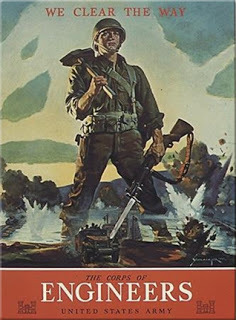 Seventy years ago, in July 1942, the armies of democracy battled the armies of totalitarianism, but a smaller battle raged between US Army Engineers and a little bird called the sooty tern.
Seventy years ago, in July 1942, the armies of democracy battled the armies of totalitarianism, but a smaller battle raged between US Army Engineers and a little bird called the sooty tern. While researching the Army engineers for my upcoming novel With Every Letter (Revell, September 2012), I ran into an intriguing little story in Barry Fowle's Builders and Fighters: US Army Engineers in World War II (Fort Belvoir VA: Office of History, US Army Corps of Engineers, 1992).
Airfields Needed
The United States and its "arsenal of democracy" cranked out thousands of fighter planes, bombers, and cargo planes for Allied forces fighting in Britain, North Africa, the Middle East, and the Pacific. Transporting those planes over the Atlantic and Pacific Oceans became a serious problem as the Germans and Japanese expanded their territories. The trans-Atlantic air routes traversed Newfoundland, Greenland, and Iceland, but these routes were hazardous in winter months. A southern route was greatly desired.
Ascension Island
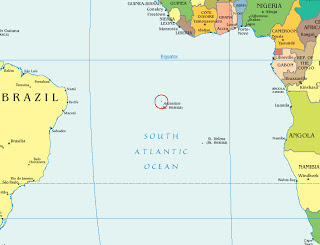
Conveniently located about halfway between South America and Africa, the British territory of Ascension Island offered an alternative. This little 34-square-mile volcanic island has no natural harbor, but has flat areas ideal for airfields.
Wideawake Field
In February 1942, the 38th Combat Engineer Battalion of the US Army Corps of Engineers arrived to build Wideawake Field, named for native sooty terns, also called "wideawakes" for their sleep-disturbing calls. The engineers built a 6000-foot runway, which opened for traffic on July 7, 1942. When Brazil declared war on the Axis in August, opening crucial air bases to Allied planes, this route carried large quantities of planes to the front.
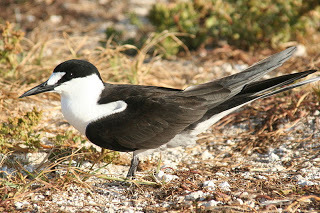 The Sooty Tern
The Sooty TernHowever, a large rookery of sooty terns lay at the end of the runway. Takeoffs and landings flushed out clouds of birds, and birds and planes don't mix. Smoke candles and dynamite blasts failed to convince the terns to relocate to other areas of the island. A planeload of cats was brought in. Sadly, as the author writes in Builders and Fighters, "strong-beaked booby birds on the island...found the cats an appetizing treat." Following the advice of ornithologist James Chapin of the American Museum of Natural History, they destroyed 40,000 eggs. The terns wisely relocated to a no-fly zone of the island. The engineers, displaying the resourcefulness and ingenuity of their profession, found the tern's guano made good bricks for constructing base housing.
Published on July 09, 2012 05:00
Today in World War II History
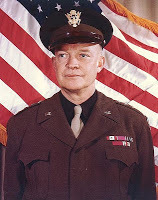 70 Years Ago—July 9, 1942: German Army Group South divided into Army Group A and Army Group B. Dwight Eisenhower promoted to lieutenant general.
70 Years Ago—July 9, 1942: German Army Group South divided into Army Group A and Army Group B. Dwight Eisenhower promoted to lieutenant general.
Published on July 09, 2012 03:00
July 8, 2012
Today in World War II History
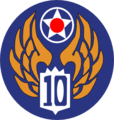 70 Years Ago—July 8, 1942: Brig. Gen. Claire Chennault takes command of China Air Task Force in US 10th AF, which has absorbed his Flying Tigers. US Army Air Force adds rank of Flight Officer for enlisted pilots.
70 Years Ago—July 8, 1942: Brig. Gen. Claire Chennault takes command of China Air Task Force in US 10th AF, which has absorbed his Flying Tigers. US Army Air Force adds rank of Flight Officer for enlisted pilots.
Published on July 08, 2012 03:00
July 7, 2012
Today in World War II History
 70 Years Ago—July 7, 1942: US Army Air Force opens Wideawake Field on Ascension Island, opening South Atlantic route for two-engine planes and some fighters. In New Guinea, Australian troops begin march over Owen Stanley Range from Port Moresby toward Kokoda. US Army Air Force sinks first submarine—a Hudson sinks U-701 off Wilmington, NC.
70 Years Ago—July 7, 1942: US Army Air Force opens Wideawake Field on Ascension Island, opening South Atlantic route for two-engine planes and some fighters. In New Guinea, Australian troops begin march over Owen Stanley Range from Port Moresby toward Kokoda. US Army Air Force sinks first submarine—a Hudson sinks U-701 off Wilmington, NC.
Published on July 07, 2012 03:00
July 6, 2012
Today in World War II History
70 Years Ago—July 6, 1942: Anne Frank’s family goes into hiding in Amsterdam. Japanese land on Guadalcanal to build air base. Australia begins tea rationing (1 lb/5 weeks).
Published on July 06, 2012 03:00



